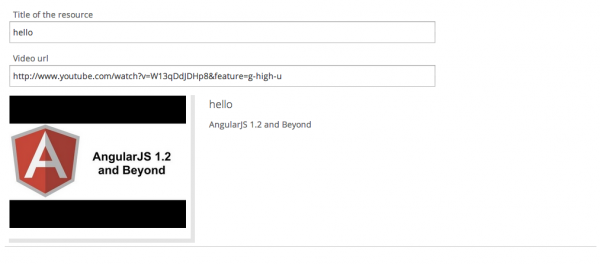This blog post comes on the back of the Moodle moot conference we attended in Edinburgh this month. As in most conferences we received many comments from the Moodle community such as this one by Mark Andrews, University of Cambridge:
“Sussex University seems to have sorted out all the problems we have with Moodle“
Well Mark, of course we haven’t, but we have made steps in the right direction.
Mark’s and comments like this led us to believe it would be useful to offer some recommendations for Moodle HQ. This post offers advice based on our experiences of working with Moodle in an HE institution for the last 10 years.
1. You don’t need more PHP developers you need more designers
The strength of our Moodle install is not a result of the strength of our development team. We have only ever had two developers. The strength of our Moodle comes as a result of listening to the advice of someone with design, user experience and generic content management system expertise.
In 2010 we hired Stuart Lamour who was a UX designer with large amount of experience in web based CMS such as WordPress, Drupal and Joomla. Working with Stuart we were able to identify the key factors about our Moodle install which made teachers create online courses that were little more than long lists of attachments with links to an occasional activity.
We were then able to identify key changes to the user interface design which would change the teachers workflow and improve the Moodle courses that they created.
It wasn’t difficult to change Moodle to work as we would have liked – it just needed a little inspiration and common sense advice, which wasn’t nearly as common as you might think.
If Moodle takes the advice of a similar UX designer they will be able to produce a highly usable Moodle that works for all sectors of the community.
2. Follow the Market leaders of social media
Social media is adopted by people because it is easy and enjoyable to use. Facebook, Twitter, Pinterest, Google+ are used because they have the user interface right.
In contrast, enterprise systems are bought by purchasers and managers who often don’t use the system. Using enterprise systems is often unintuitive and wastes employees’ time as they wrestle with them. Employees are paid to use them, but their user interface often stinks. When was the last time you were frustrated by your institution’s finance or student record system?
Moodle is an enterprise system. It has been adopted by a critical mass. It won’t go anywhere soon, but that doesn’t mean we shouldn’t be improving its usability. Our tutors deserve an interface that is intuitive so that they can focus on teaching and not Moodle course administration.
3. Focus on Moodle core functionality
Moodle core needs to be consolidated because the core of Moodle still isn’t as good as it should be, including many of the “social constructivist” activity modules.
It should not spend time focusing on non-core features such as messaging and further integrations
Remember, the core Moodle function for the core of Moodle adopters is to make it easy for non-technical teachers to create online content and activities from which students can learn.
4. Consider Moodle courses as a bespoke textbook
At all levels of education, teachers refer to textbooks. The strength of systems like Moodle is that the non-technical teachers can create their own online textbooks, specifically for the curriculum they intend to cover.
Textbooks usually include activities to complete at the end of the chapter. In VLEs like Moodle, the activities they set can be varied, social and dynamic – more so than activities in a traditional textbook.
Martin D commented that our Moodle courses were just like the Book module. My reply is:
“Yes, and this is no surprise – we consider Moodle courses to be online textbooks tailored to the needs of the course’s curriculum”
5. Navigation needs to be clear and clean
Like textbooks, Moodle courses need a contents page and chapters.
These elements of a textbook match to the Moodle navigation block and Moodle sections.
What do content pages of books look like?
They are clear and clean! Moodle’s navigation block needs to be the same.
What do book chapters look like?
Well, we’d say they are clearly demarcated areas with related content.
This leads us to argue that Moodle sections (chapters) need to be clearly separated on different pages with introductions to each. And this does not need to be another configuration setting – it just needs to be so.
We’d also recommend that Moodle does not need the option to pre-specify the number of topics in a course. You start with one. If course tutors need more they will add them.
The principle is the creator of a textbook doesn’t start with ten chapters they need to fill. They start with one and go on from there.
It is as well to remember that non-experts do not like deleting things, so if you create a course with ten sections there will remain ten sections and some will be empty (and by the way, that means you should also start courses with the minimum number of blocks).
And again “no” – we don’t care that this is a configuration setting at the site level – it shouldn’t be. Which leads us to our next point:
6. Stop the proliferation of configuration variables
While some configuration variables are needed, others simply indicate software designers not being able to make a decision. We need to be decisive and focus on our core functionality and core user sets. Other configurations of Moodle can be catered for by plugins or flavours. However, until Moodle is really an industry standard VLE/LMS, we need to keep focused on the core functionality and core user groups.
7. Moodle course administration needs to be improved
Course administration in Moodle is just another block. It shouldn’t be. Course administration needs a clear separation from the course creation and design. It is ontologically different. In most systems, including our own now we have modified it, it is called a “Dashboard“.
Like in other content management systems such as WordPress, Blogger and Tumblr administration pages do not need to look anything like the course pages. In fact it probably helps if they look different because they will need their own navigation elements.
8. Make it easy to make content
We used to complain about the Moodle “scroll of death”. Then infinite scrolling came along and we questioned if our complaint was valid.
It was.
Unlike social media platforms’ scroll Moodle courses usually lack interesting content. It is just a scroll of anonymous links.
This is still a reality for many Moodle users today, but not so in our Moodle install. We changed the interface in line with social media platforms so teachers intuitively create content-rich courses for their students.
Here are some of the tactics we employed:
- We required each new section within a course to have a section name – as you would expect a chapter to have name. The system auto-builds the navigation menu using that name.
- Whenever a section is created a textarea field is opened which expects the teacher to enter introductory text – as you would expect a chapter of a textbook to have introductory text.
- We called the label resource “content” and we made the page resource open within the course front page as an accordion. We improved the display of other resource types too so they were more than just links.
- When adding videos and images we display a thumbnail.
- When adding an activity we made it a substantial addition to the course with important metadata such as the opening and closing dates. We made it more than a link!
Changes such as these have made our teachers more likely to create Moodle courses which are attractive and rich in content.
9. Have notifications
Modern systems have notifications of important, relevant stuff to the user.
Moodle is their online space for their educational journey. It needs to feel alive, not dead. This is done by making updates obvious and not something they need to search for.
Notifications of relevant information, changes and social exchanges make the system a dynamic and addictive interface.
In our Moodle for example:
- Students are notified about recently released feedback on their assessments from the front page
- Students are notified about upcoming deadlines to assessments from the front page
- Students have a weekly timetable, including teaching sessions and locations from the front page
- Students are notified about additions of resources and activities to course in the user bar available from all pages – with a count of all unread additions.
- Social elements such as tutor or peer engagement in activities also appear in the user bar – with a count of unread forum posts.
Users do not have to drill down into courses to search for what is important to them or what has changed in the system. These updates indicate to the student that the system is a rich, social hub – relevant to their learning journey.
10. Create a Moodle Lite
This may seem like a lot of work. We’ve done it and it isn’t that hard – it just needs some inspiration. But our final recommendation will help Moodle handle the transition – create a Moodle Lite.
A Moodle Lite would include a front page, a user profile, a course page, a navigation block, core modules including resource, label, quiz, forum and assignment and a dashboard for general settings and enrolments. Bang!
Everything else is a downloadable plugin including the institution’s choice of authentication system.
Once these core elements are as slick as they could be, then, and only then, should Moodle HQ start improving the plugins.
Summary
We are passionate about education and supporting student learning through online tools. We really want Moodle to be an industry standard product that can meet the needs of educational institutions such as ours. We believe it has a long way to go, but that it can yet achieve its goals. We have confidence that the lead developers will start making the right decisions and taking it in the right direction.
As always, please leave any comments below and feel free to contact us.
























